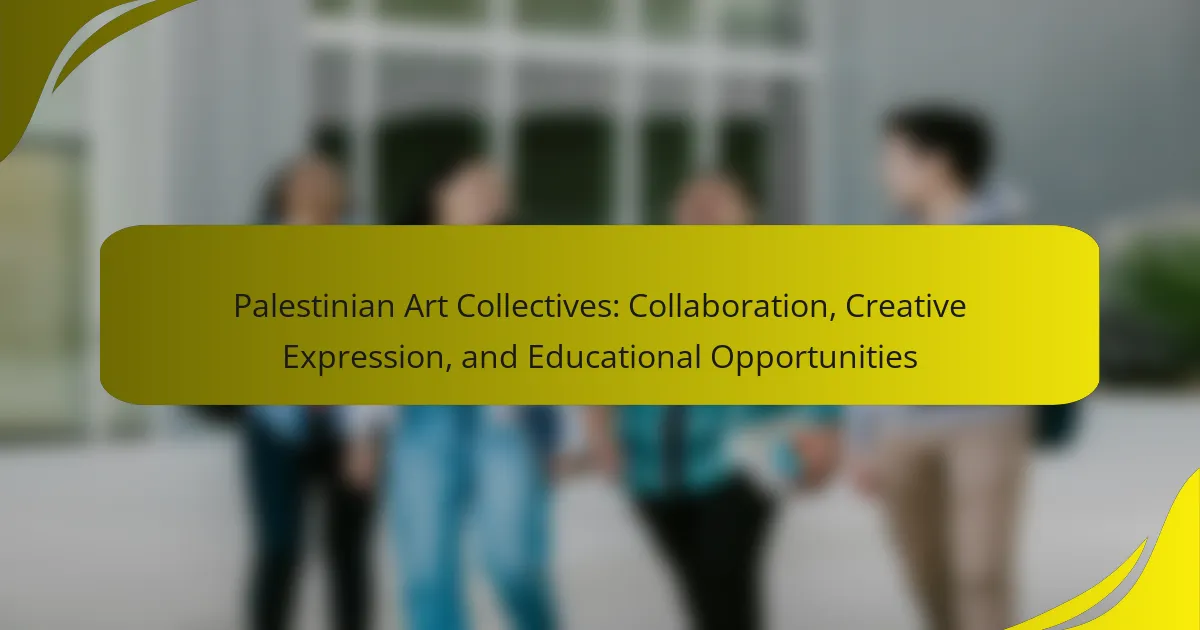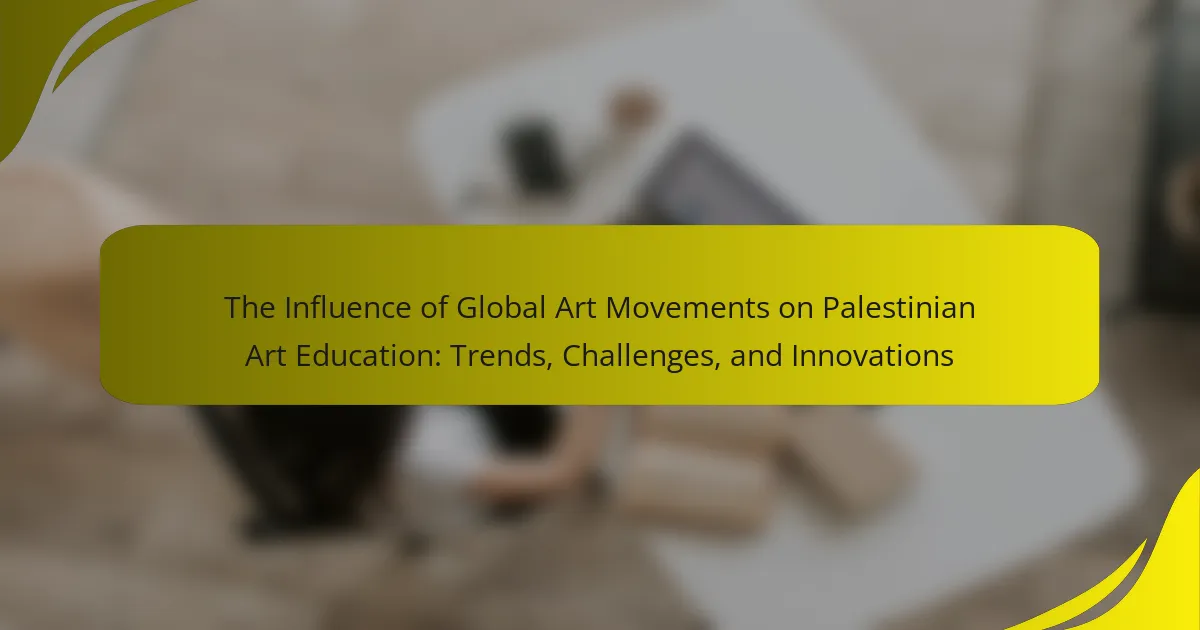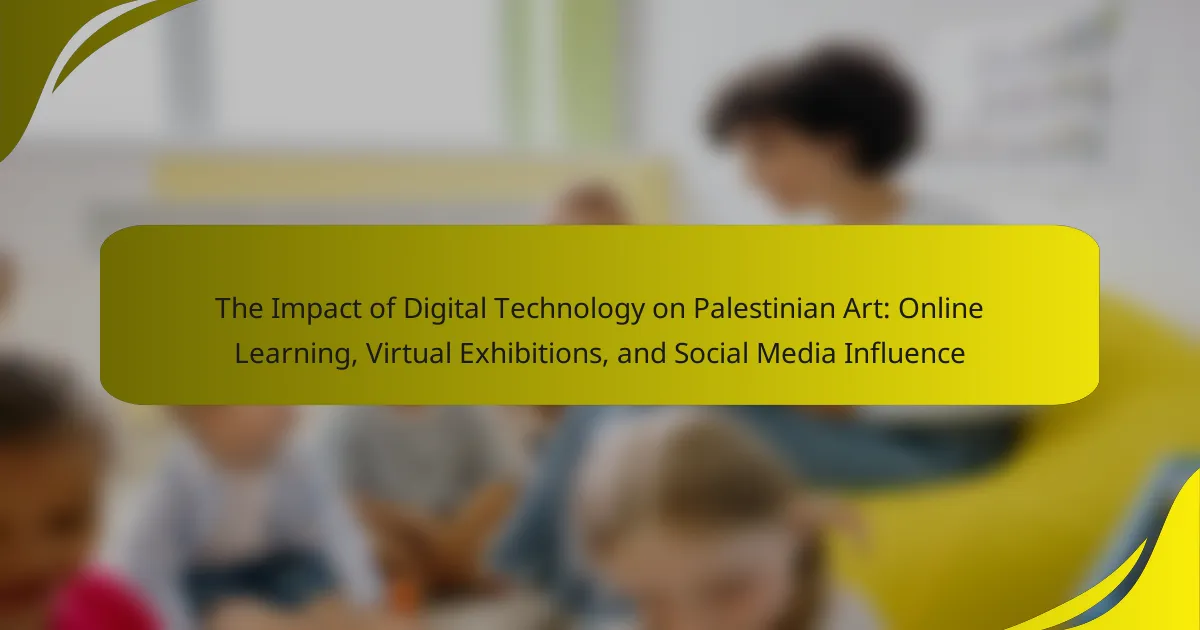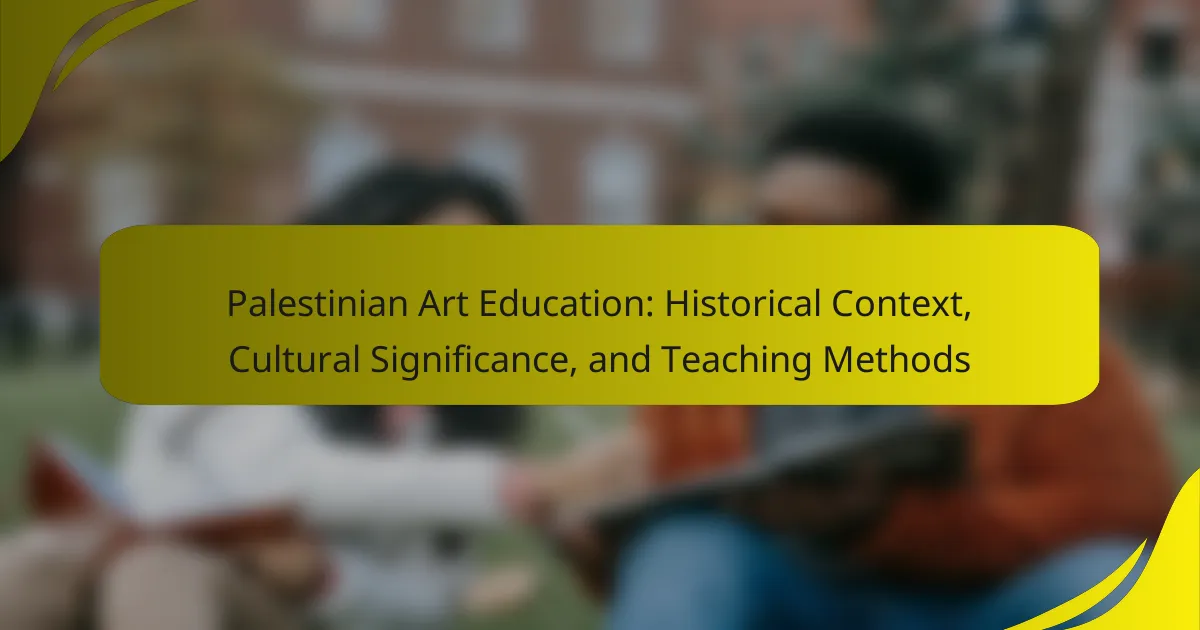Palestinian Art Education in schools is a structured program designed to impart artistic skills and foster cultural expression among students. The curriculum integrates local heritage with contemporary art practices, focusing on creativity, critical thinking, and cultural identity. Key components include drawing, painting, sculpture, and digital media, with teachers employing various strategies to engage students through hands-on projects that often highlight Palestinian history and social issues. This approach not only nurtures personal expression but also strengthens community connections. Research shows that participation in art education programs positively impacts students’ academic performance and emotional well-being.
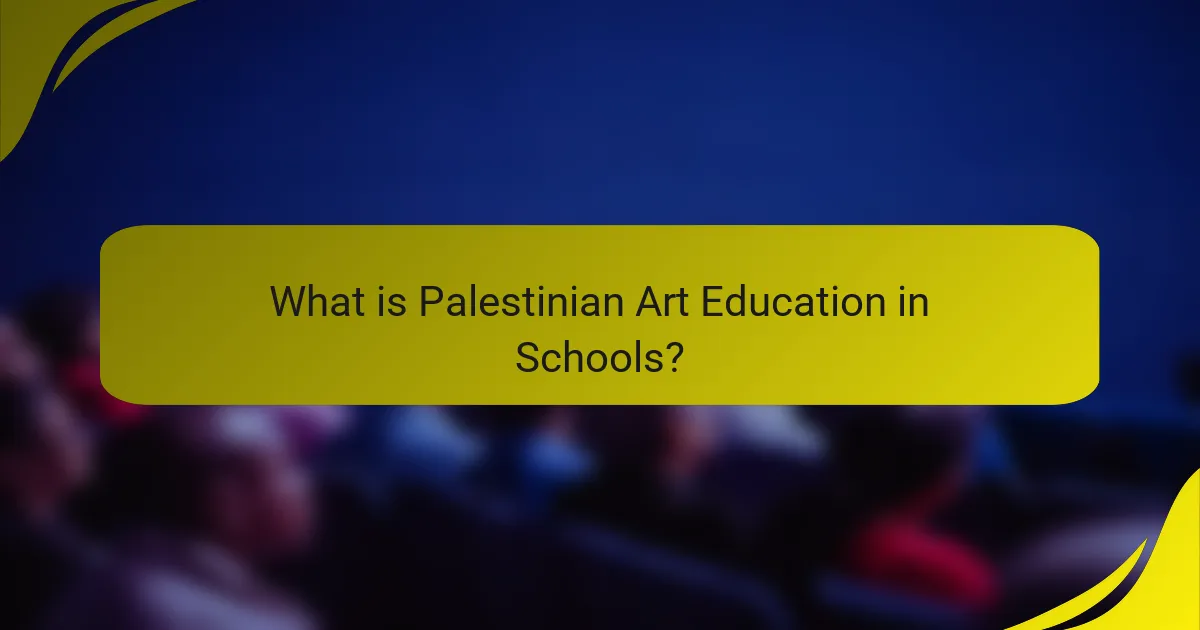
What is Palestinian Art Education in Schools?
Palestinian Art Education in schools is a structured program aimed at teaching students artistic skills and cultural expression. This education integrates local heritage and contemporary art practices. It emphasizes creativity, critical thinking, and cultural identity. The curriculum often includes drawing, painting, sculpture, and digital media. Teachers use various strategies to engage students in hands-on projects. These projects often reflect Palestinian history and social issues. Art education fosters community connections and personal expression among students. Research indicates that such programs enhance students’ overall academic performance and emotional well-being.
How is the curriculum for Palestinian art education developed?
The curriculum for Palestinian art education is developed through collaboration among educators, artists, and cultural organizations. This process involves integrating local cultural heritage and contemporary artistic practices. Stakeholders assess the educational needs of students and the community. They aim to create a curriculum that fosters creativity and critical thinking. The curriculum often includes traditional art forms, as well as modern techniques. Feedback from students and teachers is regularly incorporated to improve the curriculum. Additionally, external funding and support from international organizations can influence curriculum development. This collaborative approach ensures that the art education curriculum remains relevant and impactful.
What are the key components of the art education curriculum?
The key components of the art education curriculum include visual arts, art history, and studio practice. Visual arts provide students with the skills to create and analyze artworks. Art history offers context and understanding of various artistic movements and cultural significance. Studio practice allows students to engage in hands-on creation, fostering creativity and technical skills. Additionally, critical thinking and art appreciation are integral aspects of the curriculum. These components collectively aim to develop students’ artistic abilities and cultural awareness, preparing them for further education or careers in the arts.
How does the curriculum reflect Palestinian culture and identity?
The curriculum reflects Palestinian culture and identity through the incorporation of local history, traditions, and artistic expressions. It includes lessons on traditional crafts, folklore, and the significance of cultural symbols. Textbooks often feature Palestinian poets, artists, and historical figures. This approach fosters a sense of belonging and pride among students. Moreover, the curriculum emphasizes the importance of Arabic language and literature. It also highlights contemporary issues faced by Palestinians, promoting critical thinking about their identity. Research indicates that such educational practices strengthen cultural awareness and community ties among students.
What teaching strategies are effective in Palestinian art education?
Effective teaching strategies in Palestinian art education include project-based learning, collaborative art creation, and culturally relevant pedagogy. Project-based learning encourages students to engage deeply with art through hands-on projects. Collaborative art creation fosters teamwork and communication among students. Culturally relevant pedagogy connects art lessons to students’ cultural backgrounds, enhancing engagement and meaning. Research indicates that these strategies improve student motivation and creativity in art classes. For instance, a study by Khatib and Al-Azzam (2020) highlights the positive impact of these methods on student outcomes in Palestinian schools.
How do teachers engage students in the learning process?
Teachers engage students in the learning process through interactive teaching methods. They utilize group discussions to promote collaboration and critical thinking. Hands-on activities allow students to apply concepts practically. Visual aids enhance understanding by catering to different learning styles. Teachers also incorporate technology to make lessons more engaging. Real-world connections help students see the relevance of their learning. Feedback from students encourages participation and fosters a supportive environment. Research shows that active engagement improves retention and academic performance.
What role does technology play in art education in Palestinian schools?
Technology enhances art education in Palestinian schools by providing access to diverse resources. It facilitates online art courses and tutorials, expanding learning opportunities. Digital tools like graphic design software allow students to explore contemporary art forms. Technology also enables collaboration among students across different regions. Interactive platforms foster creativity and engagement in art projects. Furthermore, technology aids teachers in delivering innovative lessons. It supports the integration of multimedia in art presentations. Overall, technology plays a crucial role in modernizing and enriching art education in these schools.
How does student engagement impact learning outcomes in art education?
Student engagement significantly enhances learning outcomes in art education. Engaged students demonstrate higher levels of creativity and critical thinking. They participate actively in discussions and collaborative projects. This active participation leads to deeper understanding and retention of artistic concepts. Research indicates that engaged students achieve better grades in art courses. A study by the National Art Education Association found that student involvement correlates with improved artistic skills. Additionally, engaged learners often show greater motivation and enthusiasm for art. This intrinsic motivation fosters a lifelong appreciation for the arts.
What methods are used to assess student engagement in art classes?
Methods to assess student engagement in art classes include observational assessments, surveys, and portfolio evaluations. Observational assessments involve teachers monitoring student participation and interactions during art activities. Surveys can gather student feedback on their interest and involvement in art projects. Portfolio evaluations analyze the quality and creativity of students’ artwork over time. Each method provides insights into how actively students engage with the art curriculum. Research indicates that combining these methods yields a comprehensive understanding of student engagement levels.
How can teachers foster a positive learning environment for art students?
Teachers can foster a positive learning environment for art students by encouraging creativity and self-expression. They should create a safe space where students feel comfortable sharing their ideas. Providing constructive feedback helps students improve their skills. Incorporating diverse art forms can engage different interests. Establishing clear expectations promotes a structured learning experience. Collaboration among students can enhance teamwork and communication skills. Regularly showcasing student work builds confidence and a sense of achievement. Research shows that positive reinforcement can increase student motivation and participation in art classes.
What challenges do Palestinian art educators face?
Palestinian art educators face significant challenges due to political instability and restrictions on movement. These factors hinder access to resources and professional development opportunities. Limited funding for arts programs restricts curriculum development and access to materials. Additionally, societal attitudes towards art can undervalue its importance in education. Educators often navigate censorship and political pressures, affecting their teaching freedom. The lack of infrastructure for art education further complicates their efforts. These challenges collectively impact student engagement and the overall effectiveness of art education in Palestinian schools.
How do socio-political factors influence art education in Palestine?
Socio-political factors significantly influence art education in Palestine. The ongoing Israeli-Palestinian conflict affects resource allocation for educational institutions. Art programs often face funding shortages due to political instability. Restrictions on movement limit access to art supplies and educational opportunities. Cultural identity plays a crucial role in shaping the curriculum. Palestinian art education aims to preserve heritage and express resistance. Moreover, socio-political narratives are integrated into art projects. This context encourages students to engage with their history through creative expression. Thus, socio-political dynamics shape both the content and delivery of art education in Palestine.
What resources are available to support art educators in Palestinian schools?
Art educators in Palestinian schools have access to various resources. These include training programs offered by NGOs focused on arts education. Organizations such as the Palestinian Art Academy provide workshops and professional development. Additionally, educational materials are available through local and international partnerships. Art supplies are often distributed by humanitarian organizations to support creative projects. Online platforms also offer free resources and lesson plans tailored for art educators. Collaboration with local artists enhances practical learning experiences. These resources collectively aim to improve the quality of art education in Palestinian schools.
What best practices can enhance Palestinian art education in schools?
Integrating culturally relevant content enhances Palestinian art education in schools. This approach connects students to their heritage and identity. Incorporating local artists into the curriculum fosters community engagement. Providing access to diverse art materials encourages creativity and expression. Implementing collaborative projects promotes teamwork and peer learning. Offering professional development for teachers improves instructional quality. Encouraging student-led exhibitions showcases talent and builds confidence. These practices collectively enrich the educational experience and support artistic growth.
How can collaboration among educators improve art curriculum development?
Collaboration among educators can significantly enhance art curriculum development. It fosters the sharing of diverse perspectives and expertise. This exchange leads to a more comprehensive understanding of student needs. Collaborative efforts can result in innovative teaching strategies that engage students effectively. Research indicates that teamwork among teachers improves curriculum relevance and adaptability. A study by the National Art Education Association found that collaborative curriculum design increases student engagement and achievement in art. Therefore, collaboration is crucial for creating a dynamic and effective art curriculum.
What strategies can be implemented to increase student participation in art programs?
Increasing student participation in art programs can be achieved through various strategies. First, integrating art with other subjects enhances engagement. For instance, combining art with history or science can attract students from diverse academic interests. Second, offering workshops and hands-on activities encourages creativity. Research indicates that experiential learning fosters higher participation rates. Third, showcasing student artwork in school displays or community events boosts visibility and pride. A study by the National Art Education Association found that public recognition significantly increases student involvement. Fourth, providing flexible scheduling allows students to participate without conflicting commitments. Lastly, involving parents and the community in art initiatives creates a supportive environment. Engaging families can lead to increased student interest and enrollment.
Palestinian Art Education in schools is a structured program designed to teach students artistic skills while integrating local heritage and contemporary art practices. The curriculum emphasizes creativity, critical thinking, and cultural identity through various forms of artistic expression, including drawing, painting, and digital media. Key components include visual arts, art history, and studio practice, all aimed at fostering cultural awareness and community connections. Effective teaching strategies such as project-based learning and collaborative art creation enhance student engagement, while socio-political factors significantly influence the educational landscape. Resources and best practices for improving curriculum development and increasing student participation are also explored.
